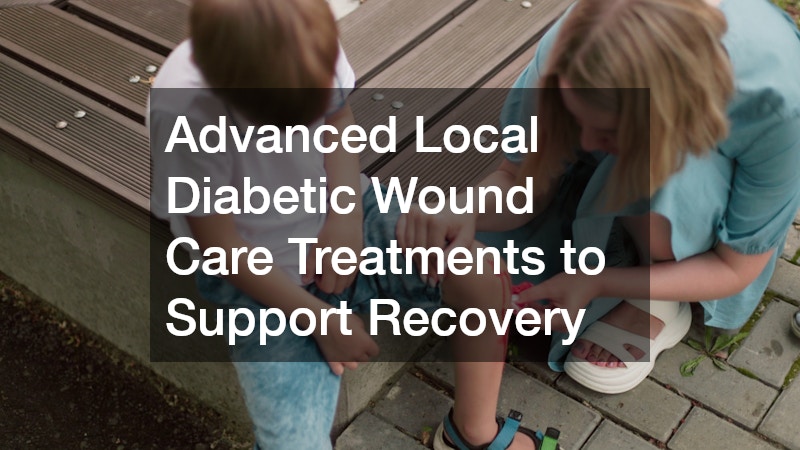
Diabetes is a pervasive health condition affecting millions globally, often leading to complications such as chronic wounds. These wounds can become serious if not managed properly, which is why it becomes imperative to have dedicated, local care solutions. This article sheds light on why local diabetic wound care is indispensable and delves into the expert practices ensuring optimal healing. With increased awareness and targeted treatments, managing diabetic wounds becomes significantly more effective and efficient.
Diabetic wounds differ notably from other wound types due to their complexity and the body’s compromised ability to heal naturally. Thus, understanding their unique nature and addressing why specialized care is essential offers a pathway to better health outcomes. This exploration also underscores the significance of local, tailored medical interventions designed specifically to handle the nuances of diabetic wound care.
We’ll also uncover the integral components required in effective wound management strategies and reinforce the overarching importance of localized care. Throughout this discussion, the focus remains on enhancing quality of life for individuals grappling with diabetes-related complications, making local wound care an indispensable part of routine healthcare for diabetic patients.
What Makes Diabetic Wounds Different from Other Types of Wounds?
Diabetic wounds pose unique challenges, primarily due to the condition’s systemic impact on circulation and nerve function. Individuals with diabetes often suffer from peripheral neuropathy, which diminishes pain sensation, thereby delaying wound detection and treatment. Furthermore, limited blood flow due to vascular issues affects nutrient delivery and waste removal from the wound site, exacerbating healing challenges and increasing the risk of infection.
This situation is compounded by the body’s impaired immune response in diabetic individuals, hindering the ability to fight infections effectively. The skin, your first line of defense, is compromised, making everyday abrasions a potential gateway for infections that can escalate without proper care. The need for specialized treatment regimens designed specifically for diabetics becomes strikingly apparent given these compounded risk factors.
Additionally, diabetic wounds often linger in particular stages of the healing process without progressing, particularly the inflammation phase. This stagnation not only prolongs healing time but also heightens susceptibility to bacterial colonization. Therefore, understanding these intrinsic differences lays the groundwork for why a targeted, specialized approach to wound care is non-negotiable for diabetic patients.
How Does Local Wound Care Improve Healing Outcomes?
Local wound care facilitates improved healing outcomes by offering a tailored approach that considers individual patient needs, their specific environment, and resources. Unlike generalized treatment methods, local wound care is personalized, ensuring that interventions are directly aligned with the patient’s situation, including accessibility to medical resources and community support systems.
Consistency in monitoring is another pivotal benefit of localized care. Regular check-ups and adjustments to treatment plans allow healthcare providers to quickly respond to any changes in the wound’s condition, thereby averting complications. The local presence of wound care specialists can make rapid interventions more feasible, ultimately supporting faster recovery and reducing hospital readmissions.
Moreover, place-based care promotes a holistically supportive atmosphere, engaging family members in the care process and encouraging patients to commit to their treatment. This collaborative approach often results in greater adherence to medical advice and proactive involvement in lifestyle changes essential for optimal wound healing success.
What Are the Key Components of Effective Local Diabetic Wound Care?
Effective local diabetic wound care hinges on several key components, which collectively foster an environment conducive to healing. Infection prevention, a critical aspect of wound management, involves stringent hygiene practices, prompt treatment of other diabetic complications, and the use of antimicrobial dressings that guard against bacterial infiltration.
Moisture control is another vital element, requiring precise balance. Maintaining appropriate moisture levels promotes cellular activities essential for wound closure and reduces scar formation. Utilizing specialized wound dressings that regulate hydration yet protect against excess moisture is essential in managing this delicate balance effectively.
Patient education forms the cornerstone of local wound care. Educating patients on the importance of regular self-examinations, recognizing early signs of complications, and integrating daily care regimens empowers them to take charge of their health. This knowledge transfer not only aids in mitigating risks but also nurtures a proactive mindset towards managing diabetes-related wound issues.
Get Help Today
In conclusion, local diabetic wound care stands as a pivotal strategy in the battle against diabetes-related complications. By focusing on personalized care, consistent monitoring, and patient education, healthcare providers can significantly improve healing outcomes. These advantages underscore the necessity of localized care options tailored to the unique challenges faced by diabetic patients.
The components discussed—ranging from infection prevention to moisture control—formulate a comprehensive approach integral to managing wound health effectively. By addressing these elements through localized interventions, healthcare systems can support faster recovery; ultimately, this leads to enhanced quality of life for individuals managing diabetes.
As awareness about the complexity of diabetic wounds grows, so too must the focus on developments in specialized care techniques. Continued innovation and patient-centric strategies will undoubtedly pave the way for better health outcomes, ensuring diabetic individuals receive the comprehensive care they deserve.





